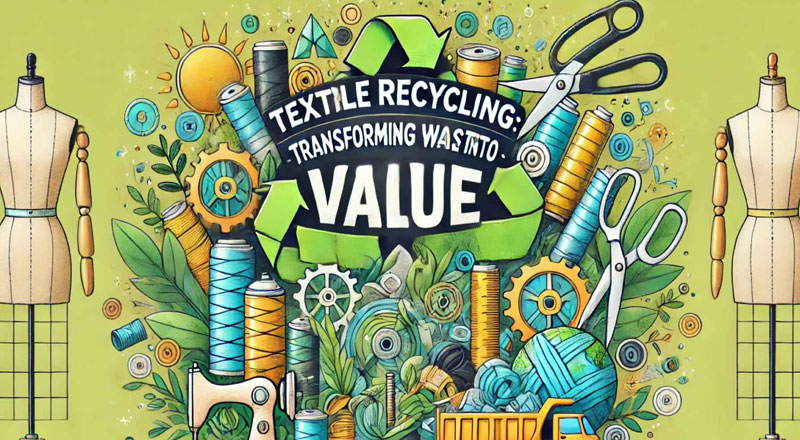The Dark Side of Fast Fashion and Textile Waste
Fast fashion has transformed the global clothing industry, making trendy outfits accessible at low prices. However, this rapid production cycle comes at a huge environmental cost. The industry generates massive amounts of textile waste, pollutes water bodies, and contributes to greenhouse gas emissions.
In India, the problem is particularly severe. With one of the largest textile industries in the world, contributing 11% to the GDP, the country produces a staggering 7,800 kilotonnes of textile waste annually. Cities like Bengaluru are struggling with overflowing landfills, while rivers such as the Noyyal in Tamil Nadu and the Bandi in Rajasthan suffer from chemical pollution due to textile industries.
Despite these alarming facts, the culture of buying and discarding clothes is growing faster than recycling efforts. Recognizing this crisis, the United Nations recently celebrated the Day of Zero Waste, emphasizing “Textile and Fashion” as a key theme. If India hopes to manage this crisis, it must rethink its approach to fashion consumption, manufacturing, and waste management.
The Driving Forces Behind Rising Textile Waste
- Fast Fashion: The Root of Overproduction and Waste
The fast fashion industry thrives on high demand and overproduction. Brands launch new collections every few weeks to keep up with trends, flooding the market with cheap, low-quality clothing. These clothes are often discarded after minimal use, leading to millions of tonnes of waste annually.
Experts highlight how consumer behaviour has changed post-pandemic:
- Ankit Jaipuria, co-founder of Zyod, a tech-driven fashion platform, explains that the rise of e-commerce and social media has encouraged impulsive shopping.
- Anurag Yashvardhan, a senior designer at Siyaram’s, notes that people buy clothes out of influence rather than necessity, fueling unnecessary consumption.
Once discarded, these textiles take years to decompose, release harmful chemicals into the soil, and increase methane emissions, worsening climate change.
- Overproduction: A Systemic Waste Problem
Overproduction in the fashion industry occurs due to inaccurate demand predictions, leading to excess stock that eventually gets discarded.
- Fabric waste starts from the production stage, with inefficient cutting techniques and excessive dye use contributing to pollution.
- The supply chain is rigid, leading to surplus inventory that brands struggle to sell. According to Ankit Jaipuria, out of the $2 trillion fashion industry, $160 billion worth of inventory is discarded.
Addressing overproduction requires a shift in manufacturing processes, better demand forecasting, and a focus on sustainable production methods.
Steps Towards Tackling Textile Waste
- Government Initiatives and Policy Measures
The Indian government has taken steps to promote sustainable textile practices:
- A tripartite Memorandum of Understanding (MoU) was signed between the Textiles Committee, Government e-Marketplace (GeM), and the Standing Conference of Public Enterprises (SCOPE) to encourage recycling of textile waste.
- Brands like H&M and Zara have adopted “Vertical Sustainability,” integrating eco-friendly practices at every production stage. Some brands are now required to include 20-30% sustainable fabrics in their collections.
- Rethinking Fast Fashion: The Role of Consumers
Consumers play a vital role in reducing textile waste. Experts suggest various approaches:
- Thrift Culture and Pre-Owned Fashion: India has a strong informal second-hand clothing market, but it needs greater mainstream acceptance.
- Tech-Driven Thrift Stores: Integrating pre-owned clothing into e-commerce platforms can make sustainable fashion more accessible.
- Promoting Slow Fashion: Encouraging people to reuse, repair, and upcycle clothes rather than discarding them can significantly reduce waste.
- Door-to-Door Collection Initiatives: Organizations like Goonj collect used clothes and repurpose them into quilts, sanitary pads, and carry bags for underserved communities.
- Leveraging Technology for Sustainable Production
- AI-driven Demand Forecasting: Predicting fashion trends accurately can reduce overproduction and prevent excess waste.
- Recycling Programs: Global brands like Uniqlo have introduced recycling bins, where customers return used garments for repurposing into new textiles. India could adopt similar models to encourage circular fashion.
- A Cultural Shift Towards Sustainability
- Reviving Traditional Practices: India’s history is deeply rooted in sustainable fashion—from khadi during the independence movement to handloom textiles that last generations.
- Encouraging Minimalism: A cultural shift towards mindful consumption—buying fewer, high-quality garments instead of excessive fast fashion—can make a significant impact.
The Future of Sustainable Fashion in India
If India continues on its current path, textile waste could reach 148 million tonnes by 2030. However, with the right policies, industry commitment, and consumer awareness, this trend can be reversed.
Possible Positive Outcomes
- Reduced Environmental Damage – Recycling and upcycling initiatives can significantly reduce pollution in rivers and landfills.
- Job Creation in Sustainable Fashion – A shift towards recycling and thrift industries can open new employment opportunities.
- Longer-Lasting Clothing – Encouraging slow fashion will help people invest in durable, high-quality clothing, leading to less waste.
Challenges and Roadblocks
- Lack of Consumer Awareness – Many people still view thrift shopping negatively, associating it with affordability rather than sustainability.
- High Cost of Sustainable Materials – Eco-friendly fabrics are often expensive, making it hard for lower-income groups to adopt sustainable fashion.
- Implementation Gaps – While government policies exist, proper execution and monitoring are crucial for them to be effective.
A Call for Collective Action
The fast fashion crisis is not just an industry issue—it’s a global environmental emergency. India, as one of the largest textile producers, must take decisive steps to tackle its growing waste problem.
Achieving a sustainable fashion future requires a multi-pronged approach:
- Stricter regulations and incentives for sustainable brands
- Expanding thrift culture and second-hand fashion
- Encouraging responsible consumer behaviour
- Investing in innovative textile recycling solutions
By rethinking fast fashion and adopting sustainable practices, India can transform its textile industry into an eco-friendly, circular economy—ensuring a cleaner, greener future for generations to come.
(With agency inputs)





